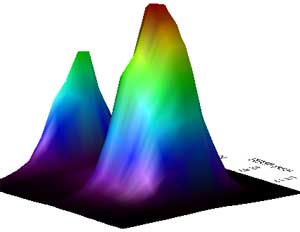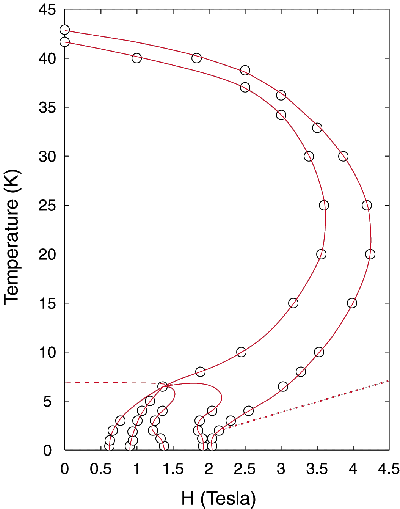Multiferroics
Materials that are both ferroelectric and magnetic—multiferroics—are rare. This is because in most ferroelectrics, such as BaTiO3, the ferroelectricity is driven by a hybridization of empty d orbitals with occupied p orbitals of the octahedrally coordinated oxygen ions. This mechanism requires empty d orbitals and thus cannot lead to multiferroic behavior. There are consequently very few ferroelectrics that exhibit long range magnetic order, and rarer still are materials where these two disparate order parameters exist and exhibit significant coupling. Multiferroics have been of particular interest recently both to understand the fundamental aspects of the novel mechanism that gives rise to this magnetic-ferroelectric coupling, as well as because of the intriguing possibility of using these coupled order parameters in novel device applications. In particular, recent "proof of principle" work has shown that it is possible to control the magnetic phase with an applied electric field, and control the electric polarization with an applied magnetic field.
The hexagonal HoMnO3 system of particular interest here is a prototype multiferroic. The holmium-oxygen displacements give rise to a ferroelectric moment along the crystallographic c axis at very high temperatures (TC = 875 K), while the Mn moments occupy a frustrated triangular lattice and order at 72 K. The magnetic structure undergoes a spin reorientation transition at 40 K (in zero field) and at ~8K, where the holmium ions also order. The order parameters are naturally coupled through the Ho-Mn exchange and anisotropy interactions.


Magnetic order parameters for HoMnO3 measured with magnetic neutron scattering. (left) isometric plot of the [1,0,1] magnetic Bragg peak and (right) integrated intensities vs. T for two different magnetic peaks. The magnetic structure changes three times in evolving to the ground state. All three magnetic structures are non-collinear, and possess different chiral symmetries. The transition at ~8K includes the development of magnetic order for the holmium moments as well as a change in the magnetic structure of the Mn spins.
The application of a magnetic field (along the c-axis) broadens and moves the spin-reorientation transition in temperature, as shown by the data below. The data allow the phase boundary to be mapped in the (H,T) plane. At low T additional transitions are observed, which are also hysteretic.

Phase diagram as a function of (H,T) determined from neutron diffraction measurements.
The spin dynamics of this system turns out to be particularly interesting. Inelastic neutron scattering measurements reveal the planar nature of the spin system, and have established the basic model for the magnetic interactions in the system. The non-collinear spin structure gives rise to three different "flavors" of bosons. The single-ion anisotropy of the (ferroelectric) holmium rare earth ions couples to the Mn spins, and appears to play a critical role in both the spin reorientation transitions (much like that found in Nd2CuO4) and in the multiferroic behavior.

Spin-wave dispersion relations at 20 K for two in-plane directions in reciprocal space, and along the c-axis (inset) where no significant dispersion is observed, indicating that the system is 2d in nature. The solid curves are fits to a 2d Heisenberg model. Dashed lines indicate two (dispersionless) crystal field levels of Ho at 1.5 and 3.1 meV. The scan shown is for Q=1.3,0,0, where the apparent sloping background is actually due to the holmium crystal field level at lower energy.
Reference: O. P. Vajk, M. Kenzelmann, J. W. Lynn, S. B. Kim and S.-W. Cheong, Phys. Rev. Lett. 94, 087601 (2005).
Additional Neutron Multiferroic Publications
Magnetic Inversion Symmetry Breaking and Ferroelectricity in TbMnO3, M. Kenzelmann, A.B. Harris, S. Jonas, C. Broholm, J. Schefer, S. B. Kim, C. L. Zhang, S.-W. Cheong, O. P. Vajk and J. W. Lynn, Phys. Rev. Lett. 95, 087206 (2005).
Structural Anomalies at the Magnetic and Ferroelectric Transition in RMn2O5, C. R. dela Cruz, F. Yen, B. Lorenz, M. M. Gospodinov, C. W. Chu, W. Ratcliff II, J. W. Lynn, S. Park, and S-W. Cheong, Phys Rev. B73, 100406(R) (2006).
Spontaneous Spin-lattice Coupling in the Geometrically Frustrated Triangular Lattice Antiferromagnet CuFeO2, F. Ye, Y. Ren, Q. Huang, J. A. Fernandez-Baca, P. Dai, J. W. Lynn, and T. Kimura, Phys. Rev. B 73, 220404(R) (2006).
Complex Magnetic Order in the Kagome Staircase Compound Co3V2O8, Y. Chen, J. W. Lynn, Q. Huang, F. M. Woodward, T. Yildirim, G. Lawes, A. P. Ramirez, N. Rogado, R. J. Cava, A. Aharony, O. Entin-Wohlman, and A. B. Harris, Phys. Rev. B 74, 014430 (2006).
Magnetic Instability and Oxygen Deficiency in Na-doped TbMnO3, C. C. Yang, M. K. Chung, W.-H. Li, T. S. Chan, R. S. Liu, Y. H. Lien, C. Y. Huang, Y. Y. Chan, Y. D. Yao, and J. W. Lynn, Phys. Rev. B74, 094409 (2006).
